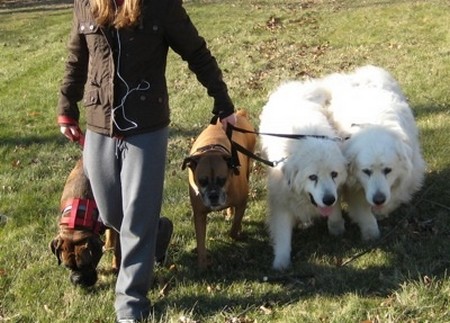A dog owner once explained to us his own way of handling the problem of walking his dog—after calling us in to help him teach his dog, Toby, to walk correctly. “When I take Toby for a walk, I place him on the lead, look at him, and say, ‘Where are we going to go today, Toby?'”
We have visited many training grounds in our time and seen many different techniques for teaching a dog to walk correctly on the lead and “at heel,” as it is commonly known, but we believe that none of these techniques is as quick or as easy as the system which we will describe here.
One reason is that these techniques use the “Heel” command, and this causes a problem right from the start: at the beginning of the exercise, the dog will have no idea at all what the word “heel” means. You may as well be using the word “bananas”!
Dogs do not understand our language. Words in themselves have no meaning to our dogs—they will respond only to the sounds of the words we utter. That is why using a command word when trying to teach a dog to walk correctly may take many weeks.
If you want your dog to learn quickly how to walk correctly on the lead, the one-word reprimand method is the quickest and easiest way. If you are reprimanding as opposed to commanding, the dog will quickly learn that it is wrong to pull. If you praise as soon as the dog stops pulling, it will also learn that it is right to walk calmly at your side.
We can explain this further by using an analogy. Imagine you were walking towards the edge of a cliff in the dark; we know it is there, but you do not.
There are two ways we could save you from disaster. The first would be by calling your name, and saying, “Come over here.” We could repeat this each time you approached the cliff edge. Although we haven’t told you why we have called you away, eventually you would work out that there was something strange going on because, being human, you can reason things out for yourself.
A dog, not having the capacity of human reasoning, would take a lot longer to work the same thing out and would continue to walk towards the cliff’s edge. The command technique would not be telling you—or the dog in a similar situation—anything about the impending disaster.
If, however, I yelled “No!” instead of giving you a command, you would immediately know you were making a mistake and stop. And doing the same thing to your dog—in this case, yelling “Bah!” or Bad!”—would stop it in its tracks immediately, if it had been taught to respond to the Word you were yelling.
That is why using the one-word reprimand method is effective: by now your dog will know the word, and will respond immediately when you use it. Using this method, as well as the correct timing, you will be able to teach your dog to behave safely in any situation. And it will also be easy to teach it to walk along calmly and quickly at your side whenever you need it to.
